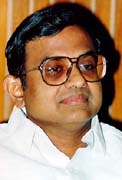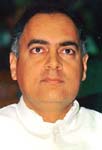Commentary/ Mani Shankar Aiyar
P Chidambaram and the assassination of Rajiv Gandhi
 Readers will recall -- and the
victim, I trust, will never forget --
my article exposing the hypocrisy and worse
of Chidambaram's tie-up with the very forces he had so roundly
condemned for their involvement in the assassination of Rajiv
Gandhi. I ended the piece deploring his fall from moral grace
but paying tribute to his 'technical brilliance'. Having
spent most of the last three months following the proceedings
of the Jain Commission, I am no longer sure I was justified in
thinking he had so won his spurs in the various ministerial offices
he held in successive Congress governments as to qualify for the
sobriquet of 'brilliance'.
Readers will recall -- and the
victim, I trust, will never forget --
my article exposing the hypocrisy and worse
of Chidambaram's tie-up with the very forces he had so roundly
condemned for their involvement in the assassination of Rajiv
Gandhi. I ended the piece deploring his fall from moral grace
but paying tribute to his 'technical brilliance'. Having
spent most of the last three months following the proceedings
of the Jain Commission, I am no longer sure I was justified in
thinking he had so won his spurs in the various ministerial offices
he held in successive Congress governments as to qualify for the
sobriquet of 'brilliance'.
His deposition over four
sessions in the witness-box has shown him up to have been a most
incompetent minister of state for internal security (1986-89)
and most negligent as minister in charge of the investigation
into Rajiv Gandhi's assassination from May 24, 1995, till his
defection to the TMC on April Fool's Day, 1996.
The Special Protection Group was established by executive
order on the first day of April 1985. It was governed by the ordinary
laws of the land but was given a mandate, powers, recruitment
methods, training, equipment and other facilities unprecedented
in the annals of India's security services.
This was to meet the
unprecedented contingency of protecting the son of an assassinated
prime minister who continued to be the target of the very terrorists
who had eliminated his mother, the threat to him having become
more acute after he won from the people, in a free and democratic
election, the largest plurality in the history of Indian democracy.
At the time, Chidambaram was a first-term backbencher.
Chidambaram's moment came on Gandhi Jayanti 1986, when the Delhi
police fell flat on their face in preventing an assassination
bid at Rajghat which, if it had succeeded, would have eliminated
both the prime minister and the President of the country from
the barrel of a single gun. The prevent a recurrence of the catastrophic
consequences for the country of any repetition of such negligence,
Rajiv Gandhi looked around him and decided to put two rising stars,
of the political and civil services firmaments respectively, in
charge of tightening security.
The two stars he picked have in
the past decade exploded into milky ways of their own in the universe
of Indian politics: P Chidambaram as minister of internal security
and T N Seshan as secretary, internal security.
Chidambaram, as befits a barrister of some standing, took upon
himself the task of drafting a law to cover the SPG. For over
three years, the SPG had functioned on the basis of an executive
order that gave it the greatest latitude. The SPG Act, which Chidambaram
piloted through Parliament in May 1988, gave the SPG juridical
definition but also circumscribed the ambit of its activity.
 Principally,
a crack police force, which had been formed for the protection
of an individual threatened by special circumstances, was redefined
by the new law as available to anyone who held the office of prime
minister, irrespective of whether the incumbent faced the same
level of threat as Rajiv Gandhi and irrespective of whether similar
protection would be available to Rajiv Gandhi, or any other Indian
similarly placed.
Principally,
a crack police force, which had been formed for the protection
of an individual threatened by special circumstances, was redefined
by the new law as available to anyone who held the office of prime
minister, irrespective of whether the incumbent faced the same
level of threat as Rajiv Gandhi and irrespective of whether similar
protection would be available to Rajiv Gandhi, or any other Indian
similarly placed.
Instead of the SPG being a specific security
response to a specific threat perception, the SPG was converted
by Chidambaram's Act into an institution of State, attached to
an office-holder and debarred by law from extension to a person
other than the office-holder. Had Chidambaram's legislative
provisions not replaced the three-year-old executive order, there
would have been no legal difficulty in extending SPG cover to
Rajiv Gandhi even after he ceased being prime minister.
|





 Readers will recall -- and the
victim, I trust, will never forget --
my article exposing the hypocrisy and worse
of Chidambaram's tie-up with the very forces he had so roundly
condemned for their involvement in the assassination of Rajiv
Gandhi. I ended the piece deploring his fall from moral grace
but paying tribute to his 'technical brilliance'. Having
spent most of the last three months following the proceedings
of the Jain Commission, I am no longer sure I was justified in
thinking he had so won his spurs in the various ministerial offices
he held in successive Congress governments as to qualify for the
sobriquet of 'brilliance'.
Readers will recall -- and the
victim, I trust, will never forget --
my article exposing the hypocrisy and worse
of Chidambaram's tie-up with the very forces he had so roundly
condemned for their involvement in the assassination of Rajiv
Gandhi. I ended the piece deploring his fall from moral grace
but paying tribute to his 'technical brilliance'. Having
spent most of the last three months following the proceedings
of the Jain Commission, I am no longer sure I was justified in
thinking he had so won his spurs in the various ministerial offices
he held in successive Congress governments as to qualify for the
sobriquet of 'brilliance'.
 Principally,
a crack police force, which had been formed for the protection
of an individual threatened by special circumstances, was redefined
by the new law as available to anyone who held the office of prime
minister, irrespective of whether the incumbent faced the same
level of threat as Rajiv Gandhi and irrespective of whether similar
protection would be available to Rajiv Gandhi, or any other Indian
similarly placed.
Principally,
a crack police force, which had been formed for the protection
of an individual threatened by special circumstances, was redefined
by the new law as available to anyone who held the office of prime
minister, irrespective of whether the incumbent faced the same
level of threat as Rajiv Gandhi and irrespective of whether similar
protection would be available to Rajiv Gandhi, or any other Indian
similarly placed.